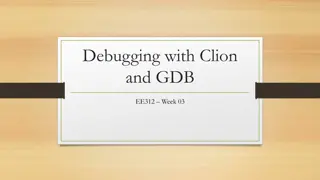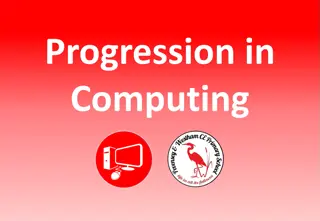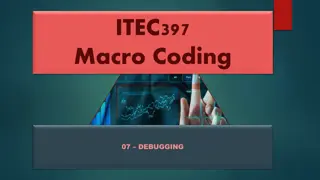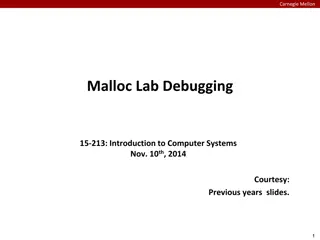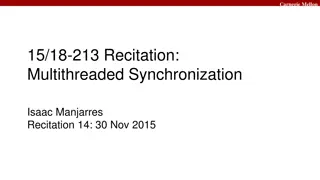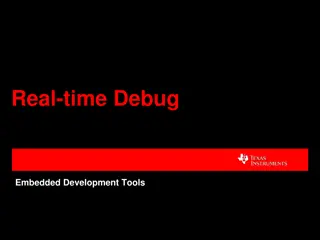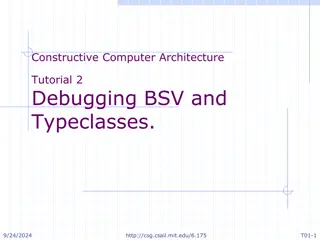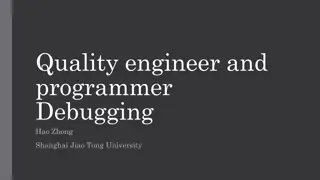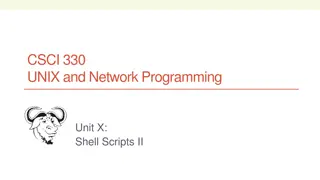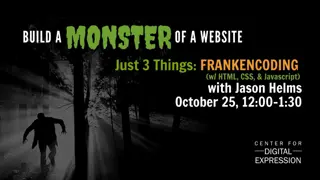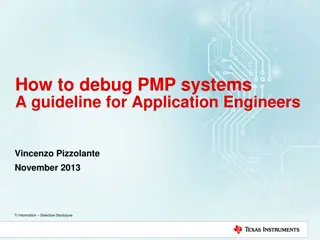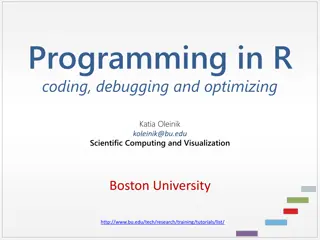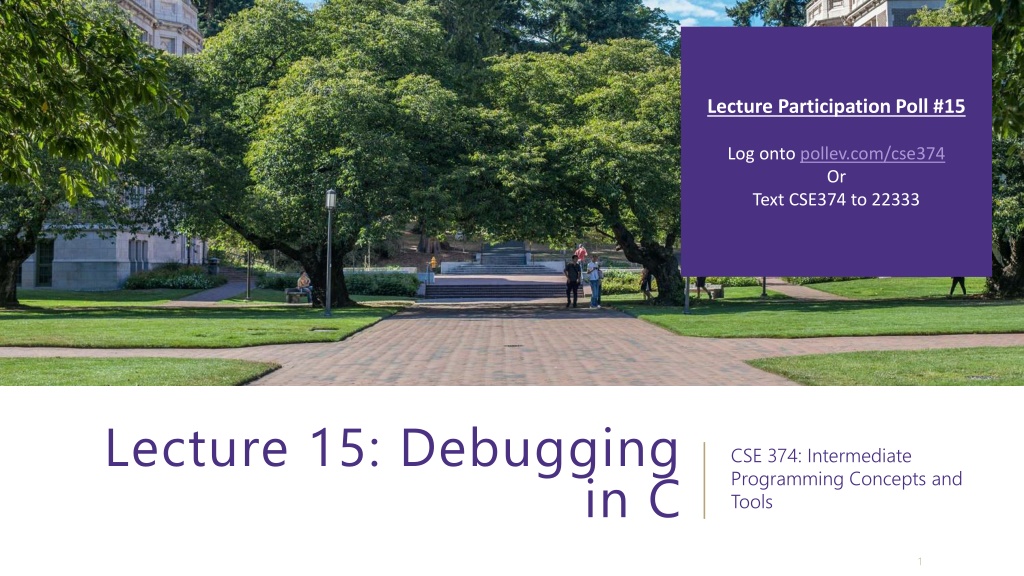
Debugging Techniques for Efficient Programming
Understand the concept of bugs in programming, learn effective debugging techniques, and explore strategies to identify and resolve code errors efficiently. Improve your programming skills by mastering the art of debugging.
Download Presentation

Please find below an Image/Link to download the presentation.
The content on the website is provided AS IS for your information and personal use only. It may not be sold, licensed, or shared on other websites without obtaining consent from the author. If you encounter any issues during the download, it is possible that the publisher has removed the file from their server.
You are allowed to download the files provided on this website for personal or commercial use, subject to the condition that they are used lawfully. All files are the property of their respective owners.
The content on the website is provided AS IS for your information and personal use only. It may not be sold, licensed, or shared on other websites without obtaining consent from the author.
E N D
Presentation Transcript
Lecture Participation Poll #15 Log onto pollev.com/cse374 Or Text CSE374 to 22333 Lecture 15: Debugging CSE 374: Intermediate Programming Concepts and Tools in C 1
Administrivia Reminder: Midpoint Deadline Friday November 6th at 9pm PST - Will post grades to canvas sometime the week after CSE 374 AU 20 - KASEY CHAMPION 2
What is a Bug? A bug is a difference between the design of a program and its implementation - Definition based on Ko & Meyers (2004) We expected something different from what is happening Examples of bugs - Expected factorial(5) to be 120, but it returned 0 - Expected program to finish successfully, but crashed and printed "segmentation fault" - Expected normal output to be printed, but instead printed strange symbols CSE 374 AU 20 - KASEY CHAMPION 3
Debugging techniques Comment out (or delete) code - tests to determine whether removed code was source of problem Test one function at a time Add print statements - Check if certain code is reachable - check current state of variables test the edges - code often breaks at the beginning or end of the loop, the entry or exit of a function <- double check logic here - double check your logic in the odd/ rare exceptional case CSE 374 AU 20 - KASEY CHAMPION 4
Debugging Basics Debugging strategies look like: Describe a difference between expected and actual behavior Hypothesize possible causes Investigate possible causes (if not found, go to step 2) Fix the code which was causing the bug Vast majority of the time spent in steps 2 & 3 CSE 374 AU 20 - KASEY CHAMPION 5
Hypothesize Now, let's look at the code for factorial() Select all the places where the error could be coming from The if statement's "then" branch The if statement's "else" branch Somewhere else int factorial(int x) { if (x == 0) { return x; } else { return x * factorial(x-1); } } CSE 374 AU 20 - KASEY CHAMPION 6
Investigate Let's investigate the base case and recursive case - Base case is the "if then" branch - Recursive case is the "else" branch int factorial(int x) { if (x == 0) { return x; } else { return x * factorial(x-1); } } Case Input Math Equivalent Expected Actual Base factorial(0) 0! = 1 1 ??? Recursive factorial(1) 1! = 1 1 ??? Recursive factorial(2) 2! = 1 * 2 2 ??? Recursive factorial(3) 3! = 1 * 2 * 3 6 ??? CSE 374 AU 20 - KASEY CHAMPION 7
Investigate One way to investigate is to write code to test different inputs If we do this, we find that the base case has a problem int factorial(int x) { if (x == 0) { return x; } else { return x * factorial(x-1); } } Case Input Math Equivalent Expected Actual 0 Base factorial(0) 0! = 1 1 0 Recursive factorial(1) 1! = 1 1 0 Recursive factorial(2) 2! = 1 * 2 2 0 Recursive factorial(3) 3! = 1 * 2 * 3 6 CSE 374 AU 20 - KASEY CHAMPION 8
Fix int factorial(int x) { if (x == 0) { return x; } else { return x * factorial(x-1); } } int factorial(int x) { if (x == 0) { return 1; } else { return x * factorial(x-1); } } Case Input Math Equivalent Expected Actual 1 Base factorial(0) 0! = 1 1 1 Recursive factorial(1) 1! = 1 1 2 Recursive factorial(2) 2! = 1 * 2 2 6 Recursive factorial(3) 3! = 1 * 2 * 3 6 CSE 374 AU 20 - KASEY CHAMPION 9
C Debugger A debugger is a tool that lets you stop running programs, inspect values etc - instead of relying on changing code (commenting out, printf) interactively examine variable values, pause and progress set-by-step - don t expect the debugger to do the work, use it as a tool to test theories - Most modern IDEs have built in debugging functionality gdb -> gnu debugger, standard part of linux development, supports many lan gyages - techniques are the same as in most debugging tools - can examine a running file - can also examine core files of previous crashed programs Want to know which line we crashed at (backtrace) Inspect variables during run time Want to know which functions were called to get to this point (backtrace) CSE 374 AU 20 - KASEY CHAMPION 10
Meet gdb Compile code with -g flag (saves human readable info) Open program with gdb <executable file> start or restart the program: run <program args> - quit the program: kill - quit gdb: quit Reference information: help - Most commands have short abbreviations - bt = backtrace - n = next - s = step - q = quit - <return> often repeats the last command CSE 374 AU 20 - KASEY CHAMPION 11
CSE 374 AU 20 - KASEY CHAMPION 12 https://courses.cs.washington.edu/courses/cse374/19sp/refcard.pdf
Useful GDB Commands bt stack backtrace up, down change current stack frame list display source code (list n, list <function name>) print expression evaluate and print expression display expression - re-evaluate and print expression every time execution pauses - undisplay remove an expression from the recurring list info locals print all locals (but not parameters) x (examine) look at blocks of memory in various formats If we get a segmentation fault: 1. gdb ./myprogram 2. Type "run" into GDB 3. When you get a segfault, type "backtrace" or "bt" 4. Look at the line numbers from the backtrace, starting from the top CSE 374 AU 20 - KASEY CHAMPION 13
Breakpoints break sets breakpoint - break <function name> | <line number> | <file>:<line number> temporarily stop program running at given points - look at values in variables - test conditions - break function (or line-number) - conditional breakpoints - to skip a bunch of iterations - to do assertion checking info break print table of currently set breakpoints clear remove breakpoints disable/enable temporarily turn breakpoints off/on continue resume execution to next breakpoint or end of program step - execute next source line next execute next source line, but treat function calls as a single statement and don t step in finish execute to the conclusion of the current function - how to recover if you meant next instead of step CSE 374 AU 20 - KASEY CHAMPION 14
gdb demo CSE 374 AU 20 - KASEY CHAMPION 15
reverse.c Output is an empty C string, zero characters followed by a null terminator CSE 374 AU 20 - KASEY CHAMPION 16
Testing Computers don t make mistakes- people do! I m almost done, I just need to make sure it works Naive 14Xers Software Test: Software Test: a separate piece of code that exercises the code you are assessing by providing input to your code and finishes with an assertion of what the result should be. 1. 2. 3. 4. 5. 6. Isolate Break your code into small modules Build in increments Make a plan from simplest to most complex cases Test as you go As your code grows, so should your tests CSE 373 SP 18 - KASEY CHAMPION 17
Types of Tests Black Box Black Box - Behavior only ADT requirements - From an outside point of view - Does your code uphold its contracts with its users? - Performance/efficiency White Box White Box - Includes an understanding of the implementation - Written by the author as they develop their code - Break apart requirements into smaller steps - unit tests break implementation into single assertions CSE 373 SP 18 - KASEY CHAMPION 18
What to test? Expected behavior - The main use case scenario - Does your code do what it should given friendly conditions? Forbidden Input - What are all the ways the user can mess up? Empty/Null - Protect yourself! - How do things get started? Boundary/Edge Cases - First - last Scale - Is there a difference between 10, 100, 1000, 10000 items? CSE 373 SP 18 - KASEY CHAMPION 19
Tips for testing You cannot test every possible input, parameter value, etc. - Think of a limited set of tests likely to expose bugs. Think about boundary cases - Positive; zero; negative numbers - Right at the edge of an array or collection's size Think about empty cases and error cases - 0, -1, null; an empty list or array test behavior in combination - Maybe add usually works, but fails after you call remove - Make multiple calls; maybe size fails the second time only
Appendix CSE 374 AU 20 - KASEY CHAMPION 21

